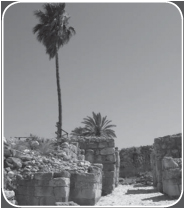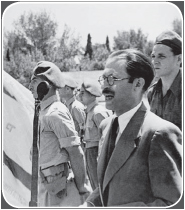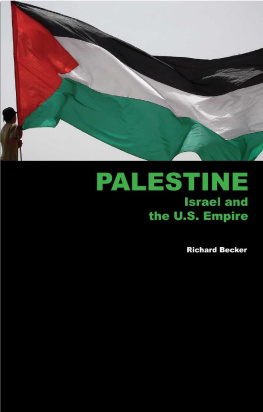HISTORIC PALESTINE, ISRAEL, AND THE EMERGING PALESTINIAN AUTONOMOUS AREAS
MIDDLE EAST
REGION IN TRANSITION
HISTORIC PALESTINE, ISRAEL, AND THE EMERGING PALESTINIAN AUTONOMOUS AREAS
EDITED BY LAURA S. ETHEREDGE, ASSOCIATE EDITOR, MIDDLE EAST GEOGRAPHY

Published in 2011 by Britannica Educational Publishing
(a trademark of Encyclopdia Britannica, Inc.)
in association with Rosen Educational Services, LLC
29 East 21st Street, New York, NY 10010.
Copyright 2011 Encyclopdia Britannica, Inc. Britannica, Encyclopdia Britannica, and the Thistle logo are registered trademarks of Encyclopdia Britannica, Inc. All rights reserved.
Rosen Educational Services materials copyright 2011 Rosen Educational Services, LLC.
All rights reserved.
Distributed exclusively by Rosen Educational Services.
For a listing of additional Britannica Educational Publishing titles, call toll free (800) 237-9932.
First Edition
Britannica Educational Publishing
Michael I. Levy: Executive Editor
J.E. Luebering: Senior Manager
Marilyn L. Barton: Senior Coordinator, Production Control
Steven Bosco: Director, Editorial Technologies
Lisa S. Braucher: Senior Producer and Data Editor
Yvette Charboneau: Senior Copy Editor
Kathy Nakamura: Manager, Media Acquisition
Laura S. Etheredge: Associate Editor, Middle East Geography
Rosen Educational Services
Jeanne Nagle: Senior Editor
Nelson S: Art Director
Cindy Reiman: Photography Manager
Nicole Russo: Designer
Matthew Cauli: Cover Design
Introduction by Laura Loria
Library of Congress Cataloging-in-Publication Data
Historic Palestine, Israel, and the emerging Palestinian autonomous areas edited by Laura S. Etheredge. 1st ed.
p. cm. (Middle East: region in transition)
In association with Britannica Educational Publishing, Rosen Educational Services.
Includes bibliographical references and index.
ISBN 978-1-61530-395-3 (eBook)
1. PalestineHistory. 2. PalestinePolitics and government. 3. PalestineSocial conditions. 4. IsraelHistory. 5. IsraelPolitics and government. 6. IsraelSocial conditions. 7. West BankHistory. 8. West BankPolitics and government. 9. West BankSocial conditions. I. Etheredge, Laura.
DS117.H5515 2011
956.94dc22
2010035792
On the cover (clockwise from top left): Israelis enjoy live music at a cafe bar in the centre of the northern Israeli city of Haifa, a view of Jerusalem, demonstrators in Jerusalem march in support of peace in the Gaza Strip, Palestinian men play cards at a cafe in the West Bank city of Hebron. Menahem Kahana/AFP/Getty Images; www.istockphoto.com/Oleg Babich; Shutterstock.com; Hazem Bader/AFP/Getty Images
On pages : An Israeli man and a Palestinian youth display their national flags. Jack Guez/AFP/Getty Images (above); Hazem Bader/AFP/Getty Images (below)
CONTENTS















INTRODUCTION

A lithograph of the plan for Al-Aq Mosque and the Dome of the Rock, from an 18th century Arab manuscript. The latter is a sacred spot to both Jews and Muslims. The Bridgeman Art Library/Getty Images
T he history of the region known as Palestine, especially in the 20th and 21st centuries, has been marked by conflict. Over the last century, numerous governments, leaders, and organizations have grappled with the issue of how to accommodate the interests of both Israelis and Palestinian Arabs in the region. The Arab-Israeli conflict has had a ripple effect throughout the Middle East and has extended to the Western world as well. Allegiances have shifted, and alliances have been formed, broken, and re-formed numerous times. This book examines primarily the lengthy and storied history of a region treasured by three major faiths and explains how it has changed over the course of time.
The modern-day state of Israel is part of a region historically referred to as Palestine. The name is derived from the Greek term Philistia, which referred to the land of the Philistines, who occupied the territory in the 12th century BCE. The borders of the region itself are imprecise and variously defined. For the purposes of this volume, references to Palestine will refer generally to the area reaching from the Mediterranean Sea in the west to the Jordan River in the east, and from the Israeli-Lebanese border in the north narrowing down to the Gulf of Aqaba in the south.
The people of the Stone Age in historic Palestine were cave dwellers who increasingly turned to farming, eking out an existence on arid land. The earliest known towns, established in northern and central Palestine during the Early Bronze Age, were walled, mainly independent units. Egypt had some influence over the social and cultural development of the region until weakening Egyptian rule in the region gave the Israelites the opportunity to occupy land east of the Jordan River as well as the western part of Palestine, near the end of the 13th century BCE. The Israelites established a temple from which the tenets of their monotheistic faith were spread.
Next page


































